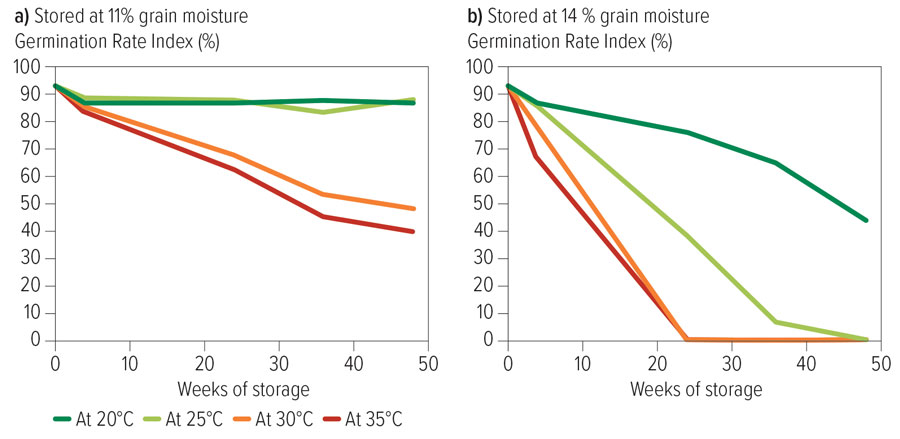As investment in on-farm storage grows, new research shows why it is critical to maintain wheat seed in cool, dry conditions
Agriculture Victoria research scientist Dr Cassandra Walker was not surprised that her study into the impact of storage conditions found that wheat seed viability declined at higher temperatures.
But what did strike her was the significant role that moisture plays, and in particular the difference in viability between grain moisture levels of 11 and 14 per cent.
“We studied two moisture levels – the upper end of what is considered safe at 11 and 14 per cent – and clearly there’s a tipping point between them where grain viability is lost,” she says. “So moisture content has a big part to play, as well as temperature, in germination potential. You can preserve grain viability for longer with lower moisture levels.”
Variety matters
The GRDC-supported research, conducted over two years, is the first of its kind looking at modern wheat varieties. It tested seven cultivars for seed viability under controlled laboratory conditions according to:
- four different temperatures (20˚C, 25˚C, 30˚C and 35˚C);
- two moisture content levels (11 and 14 per cent); and
- five storage times (harvest, 4, 24, 36 and 48 weeks).
The study found that all varieties – Boree, Brumby, EGA Gregory, LRPB Lancer, RockStar, Scepter and Sunmax – became less viable the warmer the storage temperature, the higher the moisture content and the longer they were stored (Table 1 and Figure 1).
Sunmax was the most affected, with a germination rate of 54 per cent when stored for 48 weeks at 30˚C and 11 per cent moisture. This fell to 49 per cent when the temperature was increased to 35˚C over the same time period and with identical moisture level.
RockStar was the most robust at 30˚C and moisture content of 11 per cent for 48 weeks, with an 88 per cent germination rate. Boree had the highest germination rate (82 per cent) when the temperature increased to 35˚C over the same 48-week timeframe and 11 per cent moisture.
Consistent results over several years showed that no matter the season, a decline in germination and seed viability was associated with higher grain moisture levels and storage temperatures. Across all seven varieties, the mean germination rate after 48 weeks in storage dropped to 23 per cent when both temperature (30˚C to 35˚C) and grain moisture levels (14 per cent) were high.
Table 1: Germination percentage of the different varieties tested shows some cultivars were more susceptible than others at 11% moisture content.
Variety | Germination percentage after 48 weeks | |
|---|---|---|
At 30°C and 11% moisture | At 35°C and 11% moisture | |
Boree | 85 | 82 |
Brumby | 87 | 81 |
EGA Gregory | 82 | 75 |
LRPB Lancer | 73 | 73 |
RockStar | 88 | 78 |
Scepter | 72 | 75 |
Sunmax | 54 | 49 |
Source: Dr Cassandra Walker, Agriculture Victoria
Figure 1: Germination percentage declined sharply for all seven wheat varieties within 24 weeks when temperatures exceeded 30°C under low grain moisture conditions (11%). At higher grain moisture levels (14%), germination was adversely affected across all temperature ranges.

Source: SLR Agriculture, CSIRO
On-farm impact
Dr Walker says these findings, based on rigorous scientific methodology, are important as grain storage on-farm becomes more common.
“Our research demonstrates the risks around storage systems and the importance of ensuring grain is stored at low moisture levels and is appropriately cooled or aerated,” she says. “The research drives home the storage recommendations by GRDC grain storage extension officers.”
Regular workshops and updates conducted by the GRDC Grains Storage Extension Project team led by Chris Warrick are informing growers about best practice for on-farm grain storage, including the results of Dr Walker’s research. The team has also produced the GrowNotes™ Grain Storage manual and the latest updates can be found online at the Stored Grain information hub. Direct phone support is also available via 1800 WEEVIL.
Dr Walker says the research provides a scientific basis for the challenges growers face on-farm. “It starkly illustrates the importance of what lies behind the rationale to store grain cool and with low moisture,” she says.
Even when guidelines around cool, dry storage are followed, she recommends stored grain be tested for its viability before sowing. These germination tests will inform sowing rates to ensure optimal emergence and ultimately yields, she says. “Through this research we can answer some key questions for growers that will have a big impact on realising higher yields in subsequent seasons and also reduce the risk of storing grain on-farm,” she says.
More information: Cassandra Walker, cassandra.walker@agriculture.vic.gov.au
Resources: GrowNotes™ Grain Storage and Stored Grain information hub or phone 1800 WEEVIL.

























































